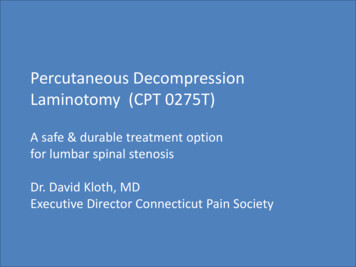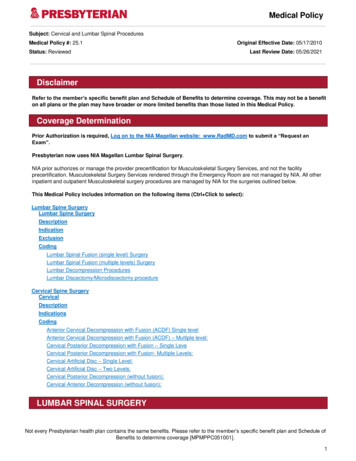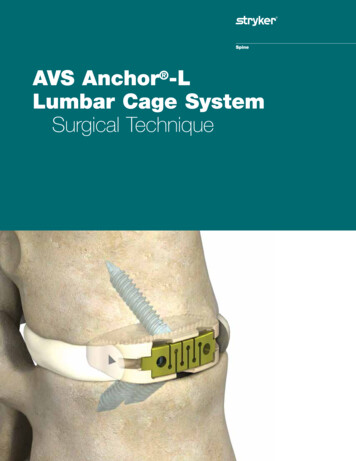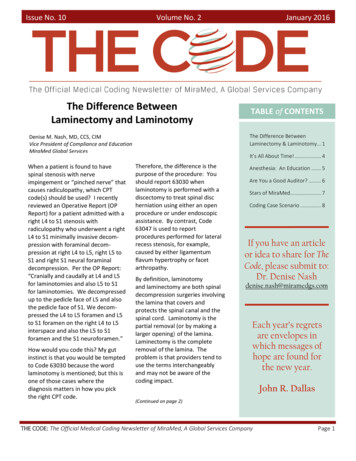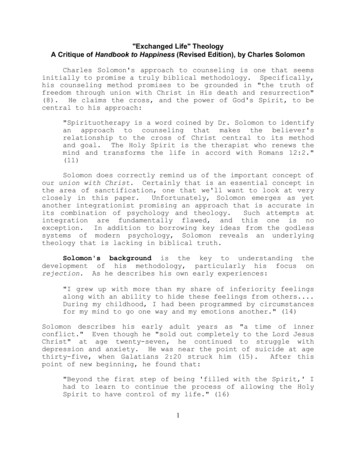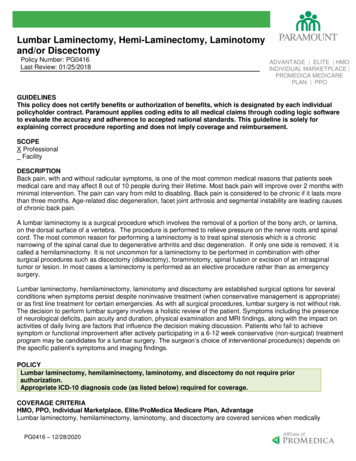
Transcription
Lumbar Laminectomy, Hemi-Laminectomy, Laminotomyand/or DiscectomyPolicy Number: PG0416Last Review: 01/25/2018ADVANTAGE ELITE HMOINDIVIDUAL MARKETPLACE PROMEDICA MEDICAREPLAN PPOGUIDELINESThis policy does not certify benefits or authorization of benefits, which is designated by each individualpolicyholder contract. Paramount applies coding edits to all medical claims through coding logic softwareto evaluate the accuracy and adherence to accepted national standards. This guideline is solely forexplaining correct procedure reporting and does not imply coverage and reimbursement.SCOPEX ProfessionalFacilityDESCRIPTIONBack pain, with and without radicular symptoms, is one of the most common medical reasons that patients seekmedical care and may affect 8 out of 10 people during their lifetime. Most back pain will improve over 2 months withminimal intervention. The pain can vary from mild to disabling. Back pain is considered to be chronic if it lasts morethan three months. Age-related disc degeneration, facet joint arthrosis and segmental instability are leading causesof chronic back pain.A lumbar laminectomy is a surgical procedure which involves the removal of a portion of the bony arch, or lamina,on the dorsal surface of a vertebra. The procedure is performed to relieve pressure on the nerve roots and spinalcord. The most common reason for performing a laminectomy is to treat spinal stenosis which is a chronicnarrowing of the spinal canal due to degenerative arthritis and disc degeneration. If only one side is removed, it iscalled a hemilaminectomy. It is not uncommon for a laminectomy to be performed in combination with othersurgical procedures such as discectomy (diskectomy), foraminotomy, spinal fusion or excision of an intraspinaltumor or lesion. In most cases a laminectomy is performed as an elective procedure rather than as emergencysurgery.Lumbar laminectomy, hemilaminectomy, laminotomy and discectomy are established surgical options for severalconditions when symptoms persist despite noninvasive treatment (when conservative management is appropriate)or as first line treatment for certain emergencies. As with all surgical procedures, lumbar surgery is not without risk.The decision to perform lumbar surgery involves a holistic review of the patient. Symptoms including the presenceof neurological deficits, pain acuity and duration, physical examination and MRI findings, along with the impact onactivities of daily living are factors that influence the decision making discussion. Patients who fail to achievesymptom or functional improvement after actively participating in a 6-12 week conservative (non-surgical) treatmentprogram may be candidates for a lumbar surgery. The surgeon’s choice of interventional procedure(s) depends onthe specific patient’s symptoms and imaging findings.POLICYLumbar laminectomy, hemilaminectomy, laminotomy, and discectomy do not require priorauthorization.Appropriate ICD-10 diagnosis code (as listed below) required for coverage.COVERAGE CRITERIAHMO, PPO, Individual Marketplace, Elite/ProMedica Medicare Plan, AdvantageLumbar laminectomy, hemilaminectomy, laminotomy, and discectomy are covered services when medicallyPG0416 – 12/28/2020
necessary as outlined below. The ICD-10 diagnosis codes that are covered for these procedures are listed below inthe CODING/BILLING INFORMATION section. When a diagnosis as listed below is not billed in one of the first fivediagnosis fields on the claim form, the procedure will be denied.IndicationsLumbar laminectomy, hemilaminectomy, laminotomy (for unilateral symptoms), and/or discectomy is consideredmedically necessary when at least one of the following criteria is met:A. Conus medullaris syndrome (spinal cord compression) confirmed by appropriate imaging studies withsevere or progressive neurologic deficits consistent with spinal cord compression (e.g., fecal or urinaryincontinence); orB. Cauda equina syndrome with neurologic deficits (bowel or bladder dysfunction, saddle anesthesia, bilateralneurologic abnormalities of the lower extremities) confirmed by physical examination and appropriateimaging studies; orC. Lumbar spinal stenosis and/or foraminal stenosis confirmed by appropriate imaging studies, with either:1. severe and progressive symptoms of pain or neurogenic claudication (buttock or leg) unresponsiveto at least 6 weeks of conservative nonoperative therapy; or2. significant motor deficit preventing ambulation; orD. Lumbar herniated intervertebral disc with nerve root compression confirmed by appropriate imaging studiesand the following additional criteria are met:1. Radicular pain with physical findings of nerve compression (for example, absent lower extremityreflex or loss of sensation in dermatomal distribution) or alternative clinical findings consistent withradiculopathy; and2. All other reasonable sources of pain have been ruled out; and3. Findings on imaging correspond to the clinical findings and neurological examination; and4. Symptoms are interfering with either:a. functional activities of daily living and persist despite at least 6 weeks of conservativenonoperative therapy; orb. are associated with significant or progressive motor deficits; orE. When performed with dorsal rhizotomy as a treatment for spasticity (e.g., cerebral palsy); orF. When performed with biopsy or excision when signs or symptoms indicative of lumbar disease (e.g., pain,motor weakness) and imaging suggests tumor or metastatic neoplasm , an infectious process (e.g., epiduralabscess) , arteriovenous malformation, malignant or non-malignant mass; orG. Acute fracture causing symptomatic nerve root compression.Note: Conservative non-operative therapy consists of an appropriate combination of medication (e.g., NonSteroidal Anti-Inflammatory Drugs [NSAIDs], analgesics), physical therapy, spinal manipulation therapy, epiduralsteroid injections, or other interventions based on the individual's specific presentation, physical findings andimaging results.Lumbar laminectomy, hemilaminectomy, laminotomy, and discectomy are considered not medically necessarywhen criteria above are not met and for all other indications not listed above as medically necessary.Documentation in the medical record must clearly support the medical necessity of the surgery and include thefollowing information:Medical History Co-morbid physical and psychological health conditions History of back surgery, including minimally invasive back procedures Prior trial, failure, or contraindication to conservative medical/non-operative interventions that may include butare not limited to the following:o Activity modification for at least 6 weekso Oral analgesics and/or anti-inflammatory medicationso Physical therapyo Chiropractic manipulationPG0416 – 12/28/2020
oEpidural steroid injectionsPhysical ExaminationClinical findings should include the patient’s stated symptoms and duration.Diagnostic TestRadiologist’s report of a magnetic resonance image (MRI) or computerized tomography (CT) scan with myelogramof the lumbar spine within the past 12 months showing a lumbar spine abnormality. Report the selective nerve rootinjection results, if it is applicable to the patient’s diagnostic workup.CODING/BILLING INFORMATIONThe appearance of a code in this section does not necessarily indicate coverage. Codes that are covered mayhave selection criteria that must be met. Payment for supplies may be included in payment for other servicesrendered.CPT CODESLaminectomy with exploration and/or decompression of spinal cord and/or cauda equina, without63005facetectomy, foraminotomy or discectomy (eg, spinal stenosis) 1 or 2 vertebral segments; lumbar,except for spondylolisthesisLaminectomy with removal of abnormal facets and/or pars interarticularis with decompression of63012cauda equina and nerve roots for spondylolisthesis, lumbar (Gill type procedure)Laminectomy with exploration and/or decompression of spinal cord and/or cauda equina, without63017facetectomy, foraminotomy or discectomy (eg, spinal stenosis), more than 2 vertebral segments;lumbarLaminotomy (hemilaminectomy), with decompression of nerve root(s), including partial63030facetectomy, foraminotomy and/or excision of herniated intervertebral disc; 1 interspace, lumbarLaminotomy (hemilaminectomy), with decompression of nerve root(s), including partial63035facetectomy, foraminotomy and/or excision of herniated intervertebral disc; each additionalinterspace, cervical or lumbar [when specified as lumbar]Laminotomy (hemilaminectomy), with decompression of nerve root(s), including partial63042facetectomy, foraminotomy and/or excision of herniated intervertebral disc, re-exploration, singleinterspace; lumbarLaminotomy (hemilaminectomy), with decompression of nerve root(s), including partial63044facetectomy, foraminotomy and/or excision of herniated intervertebral disc, re-exploration, singleinterspace; each additional lumbar interspaceLaminectomy, facetectomy and foraminotomy (unilateral or bilateral with decompression of spinal63047cord, cauda equina and/or nerve root[s], [eg, spinal or lateral recess stenosis]), single vertebralsegment; lumbarLaminectomy, facetectomy and foraminotomy (unilateral or bilateral with decompression of spinal63048cord, cauda equina and/or nerve root[s], [eg, spinal or lateral recess stenosis]), single vertebralsegment; each additional segment, cervical, thoracic, or lumbar [when specified as lumbar]Transpedicular approach with decompression of spinal cord, equina and/or nerve root(s) (eg,63056herniated intervertebral disc), single segment; lumbar (including transfacet, or lateralextraforaminal approach) (eg, far lateral herniated intervertebral disc)Transpedicular approach with decompression of spinal cord, equina and/or nerve root(s) (eg,63057herniated intervertebral disc), single segment; each additional segment, thoracic or lumbar [whenspecified as lumbar]63185Laminectomy with rhizotomy; 1 or 2 segments [when specified as lumbar]63190Laminectomy with rhizotomy; more than 2 segments [when specified as lumbar]63200Laminectomy, with release of tethered spinal cord, lumbar63252Laminectomy for excision or occlusion of arteriovenous malformation of spinal cord; thoracolumbarLaminectomy for excision or evacuation of intraspinal lesion other than neoplasm, extradural;63267lumbarPG0416 – 12/28/2020
63272632776328263287Laminectomy for excision of intraspinal lesion other than neoplasm, intradural; lumbarLaminectomy for biopsy/excision of intraspinal neoplasm; extradural, lumbarLaminectomy for biopsy/excision of intraspinal neoplasm; intradural, extramedullary, lumbarLaminectomy for biopsy/excision of intraspinal neoplasm; intradural, intramedullary, thoracolumbarLaminectomy for biopsy/excision of intraspinal neoplasm; combined extradural-intradural lesion,63290any level [when specified as lumbar]ICD-10-CM CODESLumbar laminectomy, hemilaminectomy, laminotomy, and discectomy ICD-10 codes covered ifselection criteria are met:C41.2Malignant neoplasm of vertebral columnC70.1Malignant neoplasm of spinal meningesC72.0-C72.1Malignant neoplasm of spinal cord, cauda equinaC79.49Secondary malignant neoplasm of other parts of nervous systemD16.6Benign neoplasm of vertebral columnD32.1Benign neoplasm of spinal meningesD33.4Benign neoplasm of spinal cordD42.1Neoplasm of uncertain behavior of spinal meningesD43.4Neoplasm of uncertain behavior of spinal cordG06.1Intraspinal abscess and granulomaG80.0-G80.9Cerebral palsyG82.20-G82.22ParaplegiaG83.4Cauda equina syndromeK59.2Neurogenic bowel, not elsewhere classifiedM08.1Juvenile ankylosing spondylitisM43.06-M43.07Spondylolysis, lumbar/lumbosacral regionsM43.16-M43.17Spondylolisthesis, lumbar/lumbosacral regionsM45.6-M45.7Ankylosing spondylitis, lumbar/lumbosacral regionsM47.16-M47.17Other spondylosis with myelopathy, lumbar/lumbosacral regionsM47.26-M47.27Other spondylosis with radiculopathy, lumbar/lumbosacral regionsM47.816Spondylosis without myelopathy or radiculopathy, lumbar/lumbosacral regionsM47.817M47.896Other spondylosis, lumbar/lumbosacral regionsM47.897M48.061-M48.07 Spinal stenosis, lumbar/lumbosacral regionsM48.36-M48.37Traumatic spondylopathy, lumbar/lumbosacral regionsM48.8X6Other specified spondylopathies, lumbar/lumbosacral regionsM48.8X7M51.06-M51.07Intervertebral disc disorders with myelopathy, lumbar/lumbosacral regionsM51.16-M51.17Intervertebral disc disorders with radiculopathy, lumbar/lumbosacral regionsM51.26-M51.27Other intervertebral disc displacement, lumbar/lumbosacral regionsM51.36-M51.37Other intervertebral disc degeneration, lumbar/lumbosacral regionsM51.46-M51.47Schmorl's nodes, lumbar/lumbosacral regionsM51.86-M51.87Other intervertebral disc disorders, lumbar/lumbosacral regionsM54.16-M54.17Radiculopathy, lumbar/lumbosacral regionsM54.30-M54.32SciaticaM54.40-M54.42Lumbago with sciaticaM54.5Low back painM54.9Dorsalgia, unspecifiedM96.1Postlaminectomy syndrome, not elsewhere classifiedQ27.39Arteriovenous malformation, other siteQ76.2Congenital spondylolisthesisS32.000AFracture of lumbar vertebraPG0416 – 12/28/2020
S32.059SS34.21XAS34.21XSInjury of nerve root of lumbar spineREVISION HISTORY EXPLANATIONORIGINAL EFFECTIVE DATE: 01/25/201801/25/18: Appropriate ICD-10 diagnosis code required for coverage. Policy created to reflect most current clinicalevidence per The Technology Assessment Working Group (TAWG).12/28/2020: Medical policy placed on the new Paramount Medical policy formatREFERENCES/RESOURCESCenters for Medicare and Medicaid Services, CMS Manual System and other CMS publications and servicesOhio Department of MedicaidAmerican Medical Association, Current Procedural Terminology (CPT ) and associated publications and servicesCenters for Medicare and Medicaid Services, Healthcare Common Procedure Coding System, HCPCS Releaseand Code SetsIndustry Standard ReviewHayes, Inc.PG0416 – 12/28/2020
ICD-10-CM CODES Lumbar laminectomy, hemilaminectomy, laminotomy, and discectomy ICD-10 codes covered if selection criteria are met: C41.2 Malignant neoplasm of vertebral column C70.1 Malignant neoplasm of spinal meninges C72.0-C72.1 Malignant neoplasm of spinal cord, cauda equinaFile Size: 220KB
